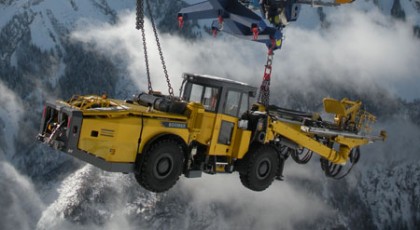Drilling in the alps
Suspended from a cable, high in the Swiss Alps, drill rigs from Atlas Copco have been hoisted to tunnel worksites at altitudes of more than 1000 meters. Project Linthal 2015 is a spectacular combination of logistics skill and tunneling expertise.
Six hundred meters inside a Swiss mountain, one of the most unique hydropower construction projects in Europe is now well under way. This is Project Linthal 2015, which involves a powerhouse cavern, a new dam, headrace and tailrace and a 5 km maze of tunnels.
With 20 different sites located more than 1 000 m high in the Alps southwest of Zurich, it is a complex and challenging task that requires robust equipment, superior engineering skill and extreme logistics expertise.
Here, in this spectacular but difficult terrain, the only viable method of transportation is a specially constructed cable car which is used for transporting all personnel and equipment ? not least entire drill rigs weighing some 36 tonnes.
Atlas Copco has delivered five drill rigs to the project in this way; three two-boom Boomer E2 C rigs equipped with COP 2238 rock drills and featuring the RCS rig control system, a Boomer 281 with COP 1838 rock drills and a two-boom Boomer L2 C with COP 1838 rock drills.
Swiss precision
Although it was the first time that Atlas Copco has used a cable car to transport complete rigs up to an Alpine site, the operation was carried out with typical Swiss precision and without a hitch.
Stephane Moser, the Atlas Copco product manager in Switzerland who supervised the operation, explains: ?We have delivered individual components this way before but this was the first time we have lifted a whole rig. There was nothing to worry about. The cable system with its 94 mm thick transport cable is a very strong construction and I was completely confident that everything would go well.
?After we got the first rig in place and adjusted the positioning to get the balance right, it was no problem at all. I must admit that it was an inspiring experience to see those rigs hanging in the air as they made their way up the mountainside.?
The cable car is used daily for various forms of transportation and is in operation almost every half hour. The journey from the base camp to the off-load area takes just 20 minutes ? a trip that Moser has now made seven times and reports that the Boomer rigs are all performing well despite some difficult geological conditions.
?The rock here is a mixture of shale, slate and schist which is typical for this area, and the formations are changing all the time,? he says. ?Despite this, we are getting an average penetration rate of 3.5 meters per minute and good life length on the drill bits, so everyone is pretty satisfied.?
Accuracy critical
Marti Tunnelbau, the tunneling contractor, is drilling and blasting a wide variety of cross sections with tunnelers working three shifts per day, seven days a week.
Some 500?700 m3 of rock is removed each day and more than 1.5 km of tunnel have been successfully excavated with a minimum of drill rig downtime.
Accuracy in the blast hole drilling operation is critical to productivity and Rolf Dubach, Site Manager for Marti Tunnelbau, the tunneling contractor, says the rigs are living up to expectations.
The rig control system (RCS) is the heart and brain of the Boomer E2 C rigs (see page 20). For example, its Advanced Boom Control system (ABC) provides accurate blast hole positioning and continuous precision drilling. This results in good rock fragmentation and accurate tunnel contours with a minimum of overbreak which, in turn, reduces the cost of reinforcement, lining and mucking-out.
Using Atlas Copco?s Tunnel Manager software, the optimal drilling pattern is fed into the rig?s control system, and the ABC system automatically guides the booms to the correct drilling position, eliminating the need to mark up the rock face.
Supporting the rock
Primary rock support is carried out with a combination of Atlas Copco Swellex rock bolts, grouted anchors and mesh, and shotcrete.
The Swellex bolts, which are expanded in the hole using high pressure water, are generally used in lengths up to 4 m while the more conventional grouted anchors are used in lengths of 4?12 m, depending on the tunnel or cavern section.
Typical rockbolt diameters range from 16 to 36 mm with bearing loads up to 450 kN. Ground water inflow has so far been limited and overall excavations have proved to be very dry, eliminating the need for grouting, or waterproofing membranes between primary and secondary linings.
Protecting the environment
Swiss construction has to meet strict environmental legislation and Project Linthal is no exception. Water has to be filtered prior to release back into the environment, vibration has to be controlled when blasting and emissions are also carefully monitored, whether from diesel engines or from the blasting process itself.
Marti Tunnelbau started the tunneling work in October 2009 and aims to be finished by 2016. Site Manager Dubach concludes: ?After this project is over, any other tunnel project that I work on in the future will seem simple by comparison.? Axpo, the Swiss energy group that will operate the new power plant, expects it to be ready to go on stream by 2015.
Epiroc operated under the trademark “Atlas Copco” prior to January 1, 2018.



Here:
Us: